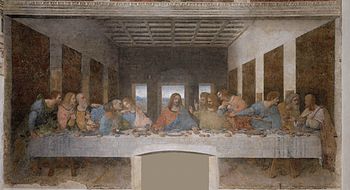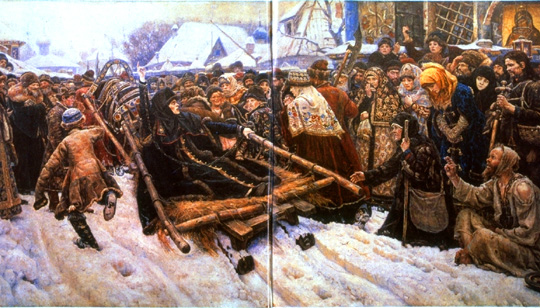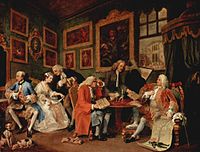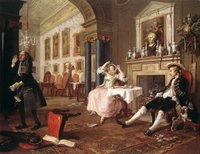
- •Answer the following questions. Be explicit:
- •Think over the following questions, looking at a painting: Reading a painting: general questions
- •Study the following text:
- •How to Read a Painting - 1
- •How to Read a Painting - 2
- •Study the following information: some styles of painting:
- •Find additional information about different painting styles: a list of the styles of painting:
- •Study the information on painting types. Look at some of the reproductions: Types (Genres) of Painting
- •Examples of Famous Paintings In All Genres
- •Portraiture Genre
- •Genre-Paintings
- •Landscape Genre
- •Still Life
- •Analyzing portraits:
- •Leonardo da Vinci. Mona Lisa (Gioconda)
- •"The Morning Walk" by Th. Gainsborough
- •Analyzing landscapes:
- •«Тайная вечеря»
- •In front of the painting ‘Boyarina Morozova’
«Тайная вечеря»
|
В «Тайной вечере» можно видеть пример мудрого понимания законов монументальной живописи, как они мыслились в эпоху Возрождения, то есть как органическая связь иллюзорного пространства фрески с реальным пространством интерьера.
«Тайная вечеря» написана на узкой стене большой продолговатой залы – трапезной монастыря Санта Мария дела Грации. На противоположном конце залы помещался стол настоятеля монастыря, и это принято во внимание художником: композиция фрески, где тоже написан стол, параллельный стене, естественно связывалась с интерьером и обстановкой. Пространство в «Тайной вечере» умышленно ограничено: перспективные линии продолжают перспективу трапезной, но не уводят далеко в глубину, а замыкаются написанной стеной с окнами – таким образом, помещение, где находится фреска, кажется только слегка продолженным, но его простые прямые очертания зрительно не нарушены. Христос и его ученики сидят как бы в этой же самой трапезной, на некотором возвышении и в нише. А благодаря своим укрупненным размерам они господствуют над пространством залы, притягивая к себе взгляд.
Христос только что произнес: «Один из вас предаст меня». Эти страшные, но спокойно сказанные слова потрясли апостолов: у каждого вырывается непроизвольное движение. Двенадцать человек, двенадцать различных характеров, двенадцать различных реакций. "Тайную вечерю» изображали многие художники и до Леонардо, но никто не ставил такой сложной задачи – выразить единый смысл момента в многообразии психологических типов людей и их эмоциональных откликов. Каждый их апостолов ищет сочувствия и отклика у соседа – этим оправдана симметричная, но выглядящая естественно разбивка на четыре группы, по трое в каждой. Только Иуда психологически изолирован, хотя формально находится в группе Иоанна и Петра. Он отшатнулся назад, тогда как все другие непроизвольно устремляются к центру – к Христу. Судорожное движение руки Иуды, его темный профиль выдают нечистую совесть.
В жесте Христа – стоическое спокойствие и горечь: руки брошены на стол широким движением, одна – ладонью кверху. Говорили, что лицо Христа Леонардо так и не дописал, хотя работал над фреской шестнадцать лет.
In front of the painting ‘Boyarina Morozova’
|
‘У художников часто бывает, что какой-то зрительный образ подсказывает им сюжет картины. Например, Крамской написал свою картину «Христос в пустыне» после того, как увидел сидящего в задумчивости на камне нищего старика. А эта картина была подсказана образом сидящей на снегу вороны.’
‘The colouring of the picture is amazing. The artist uses the entire gamut of the pallet from the white to the black. His blues, yellows and blacks are of very high saturation, and yet that does not turn the picture into a merely decorative canvas.’
‘Да, Суриков прекрасно справился с колористической и с композиционной задачей. А ведь изображение толпы на снегу ставило перед художником нелегкие задачи в этих отношениях. Кстати, в русской живописи изображение громадной массы людей на открытом воздухе было новым.’
‘What is most amazing is that the image of the boyarina, forceful as it is, dominates the canvas without obliterating the crowd. The painter created a gallery of types of characters, one more striking than the other. A most gripping picture, really.’
‘Да, совершенно верно. В композиционном отношении образ Морозовой как бы объединяет собой народную толпу, нисколько ее не затмевая. И сам благодаря ей приобретает новую значимость. Великолепный тип лица у нее, не правда ли?’
‘Oh yes, you don't forget such a face in a hurry. And how well did the artist capture the expression of this proud face and the drama of the moment!’
During the 18th century the truly national school of painting was created, William Hogarth was the first great English painter who raised British pictorial art to a high level of importance. Hogarth (1697—1764) wasn't a success as a portrait painter. But his pictures of social life which he called "modern moral subjects" brought him fame and position. Among his favourite works are six pictures united under the title "Marriage a la Mode." This famous series is really a novel in paint telling the story of the marriage of earl's son and city merchant's daughter, a marriage made for reasons of vanity and money. Despite the satirical, often amusing details, the painter's purpose is serious. He expects his pictures to be read and they are perhaps full of allusions. At the same time Hogarth remained an artist and passages especially in "Shortly after the Marriage" show how attractively he could paint. The free handing of the "Shrimp Girl" is combined with cockney vivacity. The girl is brushed onto the canvas in a vigorous impressive style. As a painter Hogarth was harmonious in his colouring, very capable and direct in his theme land composition. He painted many pictures. He is well known as a humorist and satirist on canvas.
|
|
|
The Marriage Settlement |
The Tête à Tête |
The Lady's Death |
One of the most perfect of Bruegel's human comedies is his famous picture of a country wedding. Like most pictures, it loses a great deal in reproduction: all details become much smaller, and we must therefore look at it with double care. The feast takes place in a barn, with straw stacked up high in the background. The bride sits in front of a piece of blue cloth, with a kind of crown suspended over her head. She sits quietly, with folded hands and a grin of utter contentment on her stupid face. The old man in the chair and the woman beside her are probably her parents, while the man farther back, who is so busy gobbling his food with his spoon, may be the bridegroom. Most of the people at the table concentrate on eating and drinking, and we notice this is only the beginning. In the left-hand corner a man pours out beer - a good number of empty jugs are still in the basket - while two men with white aprons are carrying ten more platefuls of pie or porridge on an improvised tray. One of the guests passes the plates to the table. But much more is going on. There is the crowd in the background trying to get in; there are the musicians, one of them with a pathetic, forlorn and hungry look in his eyes, as he watches the food being carried past; there are the two outsiders at the corner of the table, the friar and the magistrate, engrossed in their own conversation; and there is the child in the foreground, who has got hold of a plate, and a feathered cap much too large for its little head, and who is completely absorbed in licking the delicious food - a picture of innocent greed. But what is even more admirable than all this wealth of anecdote, wit and observation, is the way in which Bruegel has organized his picture so that it does not look crowded or confusing. Tintoretto himself could not have produced a more convincing picture of a crowded space than did Bruegel with his device of the table receding into the background and the movement of people starting with the crowd at the barn door, leading up to the foreground and the scene of the food carriers, and back again through the gesture of the man serving the table who leads our eyes directly to the small but central figure of the grinning bride.
Bruegel, Peasant wedding
DISCUSSION QUESTIONS
• What moment in the story has this artist chosen to portray?
• What is happening at this moment?
• How does the artist help us understand this moment in the story?
• What do you think is happening in the work of art?
• What do you see that makes you say that?
• Who do you think is the main character of this story?
• Do you recognize any of the characters? If so, how?
• What can we say about these characters?
• Describe the relationship between the different characters.
• Describe the setting.
• What time of day is it?
• What season is it?
• Where does this scene take place?
• What do you think happened ten minutes before this scene?
• What do you think will happen ten minutes later?





